Andy Lloyd's Dark Star Blog

Blog 22 (January 2015)
The Shroud
Hypothesis
The European Southern Observatory has
released a fascinating image of a star field being
obscured by a dense, dark nebula in the southern
constellation Serpens Cauda called LDN 483 (1).
It's a striking image, to be sure, looking at first
glance as if there's a dark hole in the starlit sky (2).
This is something of an optical illusion - the stars are
still there, but the light from them has been blotted
out by this immense dark molecular cloud, full of gas
and dust which lies about 700
million light years away. This 'dark nebula' is,
they tell us, the birthing ground of a new star
effectively in its foetal stage of development, just
prior to its light turning on.
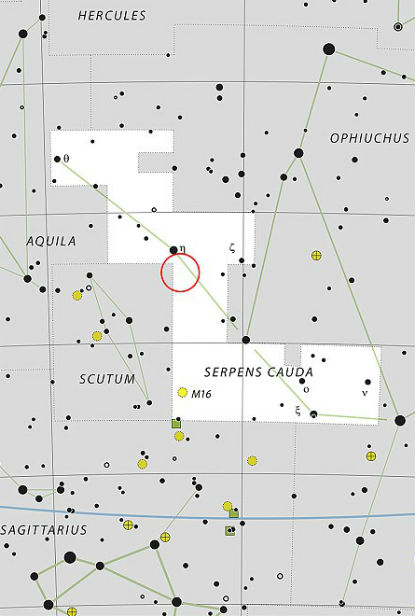
This image has got me thinking, for several reasons. My
interest is in finding a companion object to our Sun - a relatively
cool, dark sub-stellar object known as a sub-brown dwarf which might
still lurk way out there in the vast reaches of the outer solar system.
If it exists, then it has yet to be detected by visible telescope
surveys, and has evades two major infra-red sky surveys (IRAS and, more
recently, WISE). Common sense would say that this object is
unlikely, then, to exist. That said, indirect evidence that such
an object may still lie undiscovered out there continues to crop up -
much of which I have detailed in this series of monthly blogs, and on the
ever-popular Dark Star Theory
website for some years now. So, there's still something of a
mystery here, acknowledged by quite a number of astronomers expert in
the machinations of the outer solar system, whose modelling calls for
another sizeable planet to explain the gaps in their data (3,4). The
problem for all of us is this - where the hell is it?
If you're going to go about trying to
find something, it helps to know exactly what it is
you're looking for. Trying to find a missing
planet seems pretty straightforward - you would imagine
that it would reflect back some light from the Sun that
we could see in telescopes. The smaller the
planet, and the further away, the more difficult to
detect. Right? Well, yes, but that is then
made all the more tricky by acknowledging the fact that
the luminosity of reflected light rapidly drops away
with distance (by the fourth power), so that objects
beyond the planet Neptune become very, very difficult to
spot. Even so, a classic terrestrial planet calls
for a light signature, however dim, that moves
relatively rapidly across the backdrop of stars.
But what of a sub-stellar object - a
dark, smouldering object more of the dimensions of the
massive planet Jupiter? What do we know of such
objects once they've become old, and lost their initial
youthful light which is occasionally detected by hunters
of these tiny sub-brown dwarfs? Well, really, not
a lot. It's thought that brown dwarf 'stars' might
be as numerous as 'normal' stars, but you wouldn't know
it because they're damn tricky to spot. We can
only assume that their properties follow along from the
objects on either side of the planet/star spectrum.
If we are hunting for an object which
leaves its mark here and there, but remains
undetectable, then we might begin to wonder whether it
is somehow hidden from view. Might it be
wrapped up in a cloud of gas and dust that is as
obscuring to its own light and heat as it is to the
stars behind? If so, how could this come about?
Consider this: Active stars
constantly emit a wind of charged particles that drives
away the gas and dust that a condensing stellar nursery
initially consists of. So, as the stars spark into
life they not only emit vast amounts of bright new
light, but their solar winds drive away the birthing
waters that initially obscured their development.
Let there be light...
Similarly, red dwarf and active brown
dwarf stars also emit their own stellar winds, clearing
volatiles away from their systems. By contrast,
massive gas giants like Jupiter do not. So,
logically there must be a cut-off point along the
spectrum of planets and stars where sub-stellar objects
stop firing our coronal mass ejections and the like, and
thus stop sweeping their systems clear of volatiles.
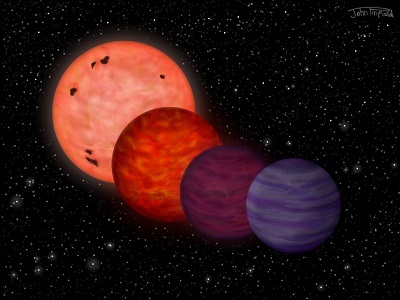
It seems totally reasonable to me to
assume that a Y Dwarf Dark Star would fall into this
category.
However, when the Y Dwarf first
formed, it would have been highly active and would have
swept its lingering accretion clouds away. If our
Dark Star is now surrounded by some kind of shroud of
gas and dust, how and when did the shroud accumulate?
I'll offer several scenarios:
1) There are many exotic
chemical processes going on in the upper atmospheres of
the brown dwarfs and their cooler cousins, the T and Y
Dwarfs. Might these smog-like clouds of gases and
dust somehow be released by the dwarfs into their
systems, but then fail to disperse due to a lack of
stellar wind? The problem would be how the smog
manages to escape the gravitational clutches of such a
massive object. Flaring might account for some
lose of upper atmosphere, but then that same flaring
should fling the gas cloud away from the Dark Star.
One can't have it both ways!
2) Highly active volcanic moons
close to the Dark Star might spew out very significant
clouds of volcanic debris into the Dark Star system over
time, which in the absence of solar wind then fails to
dissipate. Over billions of years, this might
accumulate to significant levels, assuming these moons
have plenty of matter to spare!
3) During its lifetime of
billions of years, the Dark Star will have been
repeatedly struck by comets and dwarf planets in the
outer solar system (as well as in the planetary zone
early in the life of the solar system) creating
significant impact debris fields around it which then
failed to disperse.
4) In its travels around the
galaxy, the solar system periodically encounters giant
molecular clouds. Where the positive pressure of
the solar wind up to about 80AU (the Heliopause) would
keep the planetary zone clear of this debris, a Dark
Star companion situated well beyond the Heliopause would
be completely immersed in it. Given the
substantial gravity of the Dark Star, it might well
sweep up a significant accumulation of gas and dust from
these immense clouds, acting like a Cosmic Vacuum
Cleaner. With no Solar Wind of its own to disperse
these clouds, they would simply hang about, creating an
increasingly hazy cloud of smog around the Dark Star
system. A similar scenario would also account for
the creation of the 'Kuiper Gap', a point at about 50AU
beyond which there are seemingly very few Kuiper Belt
Objects. Perhaps the Dark Star is a kind of
celestial Dust Cart, sweeping out the outer solar system
and whatever interstellar smog it might encounter.
Let's say that one or more of these
scenarios might be correct. It follows then that the
emitted heat (and any feeble light) from the Dark Star
would be blocked by the obscuring cloud it finds itself
immersed within. The system as a whole would be
shrouded in darkness.
You might wonder why accumulating gas
around such a massive body would not simply fall down
into the Y Dwarf, and be consumed by it? This is
exactly the same troublesome problem that
astrophysicists have to deal with when discussing the
origin of the solar system - why doesn't the
protoplanetary disk simply get sucked into the forming
Sun? Recent work has indicated that the system's
strong magnetic field causes currents within the disk
which prevent this outcome, helping to explain why some
matter remains to go on to form planets (5). As
such, the same effect would be true of a sub-brown
dwarf, whose own magnetic field would be considerable.
In the same way that a star's protoplanetary disk does
not completely collapse into the emerging star, an
accumulating cloud of dust and gas around an old
sub-brown dwarf would also take hold as a distinct
feature of the system.
One might imagine that such a
scenario could account for an enormous quantity of
interstellar and wide companion objects in the galaxy, providing us with an explanation
for much missing mass out there. If such obscuring
clouds commonly exist around old Y-dwarfs, then no one
would ever know because the objects would effectively
become invisible.
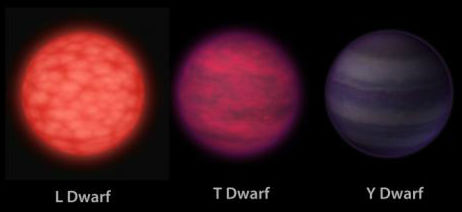
The coolest sub-Brown dwarfs
I have wondered in the past whether
we should really be looking for a smouldering presence
more like a dark cloud than just a planet or 'failed
star'. But I have always assumed, perhaps
incorrectly, that at the core of this dark aura of smog
would be a more or less visible 'core'. Perhaps I
was wrong. Perhaps the Dark Star system is wrapped
in a dense shroud of gas and dust, rather like the dark
Nebulae birthing pools. Any
planet orbiting such a sub-brown dwarf would become a
perfect hiding place from prying eyes. As long as
this shrouded Dark Star does not intrude within about
80AU of the Sun, its accompanying gas cloud would be
safe from the action of the solar wind. Nibiru,
then, would be one of the outer worlds of the Dark Star
system entering the planetary zone of the solar system
as the Dark Star skirts its periphery, as I proposed in
my 2005 book (6).
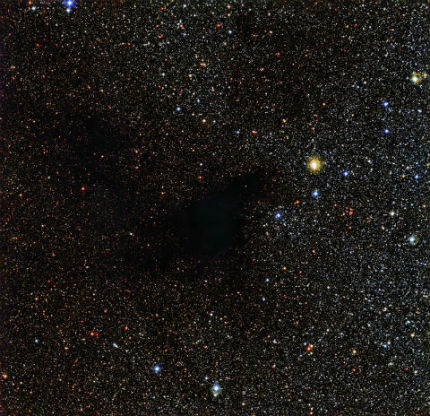
Image credit: ESO (1)
So, could LDN 483 itself be a densely
obscuring smog surrounding the Sun's own Dark Star
companion and its own planetary system? How do we
really know that LDN 483 is a vast molecular cloud 700
million light years away, and not a tiny smog-veiled
object in the outer solar system? There are a
number of ways of determining an object's distance in
space, most of which involve the measurement of
properties of its light. But a Dark Nebula
does not emit light, by definition, so astrophysicists
would have to fall back on parallax effects to do with
the seasonal movement of the Earth around the Sun (7).
There is no reason to suppose that they have
miscalculated with LDN 483 (sounds like a flight number,
doesn't it?), which means that it should not be our Dark
Star. But perhaps this does provide us with a clue
as to what we might actually be looking for out there,
and it's nothing like what astronomers have assumed so
far.
There may already be evidence of an
interaction between clouds of matter beyond the
planetary zone with the Heliopause boundary.
Studies of the properties of the Heliopause have
indicated fluctuations over time, and NASA has suggested
that the effect is due to 'interstellar fluff'
surrounding the solar system (8, 9). There appears
to be anomalous lack of uniformity in the boundary of
our solar system, which may be attributable to the
action of significant molecular clouds beyond. If
these types of clouds have aggregated around a Dark Star
over time, then they may provide us with a small, local
nebula-like entity which is extremely difficult to spot.
Written by Andy Lloyd, 12th January 2015
References:
1) European Southern Observatory
"The Dark Nebula LDN 483" 7 January 2015
eso.org article
2) Mark Prigg
"Where did all the stars go? Astronomers reveal stunning
image of giant ‘hole in the sky’ as mysterious dark
cloud obscures view" 8 January 2015, with thanks to Mart
dailymail.co.uk article
3) Andy Lloyd "New Object
in Outer Solar System Hints at Planet X" 27 March 2014
andylloyd.org/darkstarblog13.htm
4) Andy Lloyd "New Planets Await
Discovery in the Inner Oort Cloud" 20 October 2014
andylloyd.org/darkstarblog19.htm
5) Jennifer Chu "A
Strong Magnetic Field Shaped the Early Solar System" 14
November 2014
scitechdaily.com article
6)
Andy
Lloyd
"Dark
Star: The Planet X Evidence" Timeless Voyager
Press, 2005
 The Dark Star
The Dark Star
7) How do you measure the
distance from earth to a nebula?
answers.com article
8) Andy Lloyd "Heliopauses
in Collision" 12 March 2014
andylloyd.org article
9) "Our Voyage
Through the Local Interstellar Cloud -- "Different from
the Chemical Make-up Our Solar System" 15th December 2014
(no longer available online),
with thanks to Lee
Planet X Evidence Continues to
Build
New academic papers have
recently been published highlighting the possible
existence of perhaps two undiscovered Planet X objects
(1). Once again, the calculations that are leading
academic astronomers to this conclusion are based upon
the orbital trajectories of the so-called
extreme trans-Neptunian objects,
or ETNOs. These appear to show a distinctly
non-random set of orbital properties which in no
way correlate with the way theory expects them to
behave:
"Their paths
must fulfil a series of characteristics: have a
semi-major axis with a value close to 150 AU, an
inclination of almost 0° and an argument or angle of
perihelion also close to 0° or 180°. Yet what is
observed in a dozen of these bodies is quite different:
the values of the semi-major axis are very disperse
[sic]
(between 150 AU and 525 AU), the average inclination of
their orbit is around 20° and argument of Perihelion
-31°, without appearing in any case close to 180°."
(2)
The ETNOS appear to be
rambling way off the beaten path. The simplest
explanation for this increasingly puzzling anomaly is
that they are being shepherded by one or two large
Planet X bodies well beyond the limits of the Kuiper
Belt:
"The
observed excess of objects reaching perihelion near the
ascending node ... must be a true feature of this
population [ETNOs]
and its
possible origin is explored in the framework of the
Kozai effect. The analysis of several possible scenarios
strongly suggest that at least two trans-Plutonian
planets must exist." (3)
The Kozai effect relates
to the gravitational perturbation that a large body
exerts on the orbit of another much smaller and
more distant object. The Spanish
astronomers working on this problem used Jupiter's Kozai
Effect influence over comet 96P/Machholz1
as a reference for how the mechanism might work
for a proposed massive planet beyond Neptune (4).
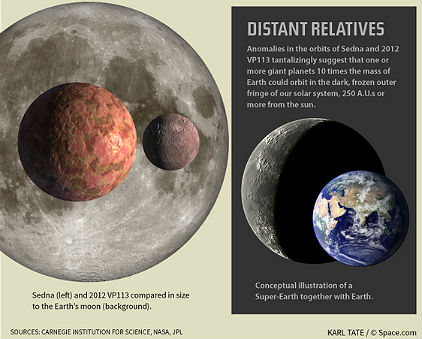
So, if a massive Planet X object exists, it should
influence the orbits of other far away objects in the
solar system in a predictable and measurable way.
Astrophysicists should therefore be able to work
backwards from a set of data of perturbed objects, like
the ETNOs, to figure out what unseen planets might be
influencing their orbits. As time goes on, and
more ETNOs are discovered and studied, then a clearer
pattern should emerge about the nature of the perturbing
influence.
(As
an aside, it's interesting that the most massive planet
in the solar system is being studied as a precedent for
this calculation. The astronomers seem to be
thinking big when it comes to Planet X!)
Up until fairly recently, it was totally
unacceptable to suggest that there might exist a massive
Planet X body beyond Neptune. Theory about how
planetary systems form precluded the formation of such
giant, outer worlds. But times change:
"The
recent discovery by the ALMA radio telescope of a
planet-forming disk more than 100 astronomical units
from the star HL Tauri, which is younger than the Sun
and more massive, suggests that planets can form several
hundred astronomical units away from the centre of the
system."
(2)
The remarkable image of planets forming in the young
protoplanetary disk of the star HL Tauri is fascinating,
to be sure.
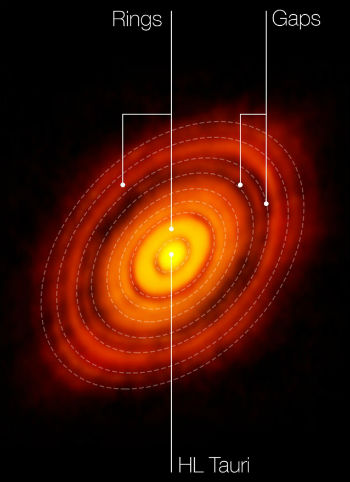
Image Credit: ALMA (ESO/NAOJ/NRAO)
The disk is barely a million years
old, but it is already clearly exhibiting the kinds of
gaps emerging from the concentric rings of gas and dust
that one would expect to see when planets form within
the swirling dust clouds:
"“These features
are almost certainly the result of young planet-like
bodies that are being formed in the disc. This is
surprising since such young stars are not expected to
have large planetary bodies capable of producing the
structures we see in this image,”ť said Stuartt Corder,
ALMA Deputy Director.
""When we first saw this image we were astounded at
the spectacular level of detail. HL Tauri is no more
than a million years old, yet already its disc appears
to be full of forming planets. This one image alone will
revolutionise theories of planet formation,” explained
Catherine Vlahakis, ALMA Deputy Program Scientist and
Lead Program Scientist for the ALMA Long Baseline
Campaign." (5)
This adds further evidence that
nascent planetary systems can extend out to great
distances. We already have precedents for wide
binary sub-brown dwarf companions to distant stars (e.g.
6). So, the old theoretical argument that a wide
binary companion cannot have formed is dead and buried.
Given the seeming influence of such a companion upon the
anomalous ETNOs, it simply remains to be seen where our
own mysterious Planet X lies - and just how big it
really is!
Written by Andy Lloyd, 19th January 2015
References:
1) Mike Wall
"Mysterious Planet X May Really Lurk Undiscovered in Our
Solar System" 16
January 2015
with thanks to Barry
space.com article
2) "There Could be
At Least Two Unknown Planets Hidden Well Beyond Pluto"
15 January
2015
(article on longer available online)
3) C. de la Fuente Marcos & R.
de la Fuente Marcos "Extreme trans-Neptunian objects and
the Kozai mechanism: signalling the presence of
trans-Plutonian planets" Monthly Notices of the
Royal Astronomical Society, 443
(1): L59-L63, 1 September 2014
mnrasl.oxfordjournals.org article
4) C. de la Fuente Marcos, et al.
"Flipping minor bodies: what comet 96P/Machholz 1 can
tell us about the orbital evolution of extreme trans-Neptunian
objects and the production of near-Earth objects on
retrograde orbits", Monthly Notices of the Royal
Astronomical Society, 446(2): 1867-1873, 2015
arxiv.org
document
5) Astronomy Now
"Planet-forming disc around young star revealed in
unprecedented detail" 6 November 2014
http://astronomynow.com/2014/11/06/alma-reveals-planet-forming-disc-around-young-star-in-unprecedented-detail/
6) N. Lodieu et al. "Binary
frequency of planet-host stars at wide separations: A
new brown dwarf companion to a planet-host star"
Astronomy and Astrophysics, 569, September 2014,
aanda.org articles
The Catastrophic
Origin of the Solar System
Last month, I discussed the new
scientific findings about the water carried by comets.
The sheer lack of ice on comets, compared to what had
been assumed previously, and the differing isotopic
ratio of the water from that on Earth has severely
challenged the 'late veneer theory', which argued that
the Earth's oceans were provided by impacting comets
over billions of years (1).
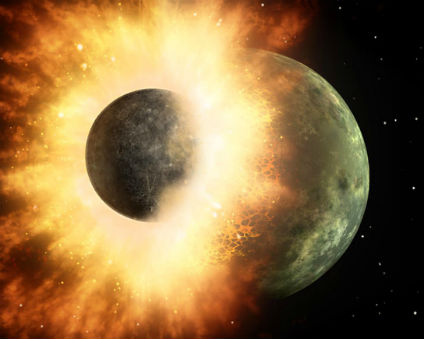
Image Credit: MIT
It had also been
assumed that a lot of the meteoritic debris that falls
to the Earth represented the leftover building blocks of
the solar system, including many of the comets and
asteroids, the latter of which are heavily composed of chondrites:
"Chondrites
were formed by the accretion of particles of dust and
grit present in the primitive Solar System which gave
rise to asteroids over 4.55 billion years ago. These
asteroid parent bodies of chondrites are (or were) small
to medium sized asteroids that were never part of any
body large enough to undergo melting and planetary
differentiation." (2)
However, this view is now changing,
too. Scientists are now thinking that the origins
of much of this debris were violent in nature, giving us
a new view of the early solar system as a far more
catastrophic place than had previously been thought
(3,4).
"Chondrules
are the millimetre-scale, previously molten, spherules
found in most meteorites... An impact origin for
chondrules implies that meteorites are a byproduct of
planet formation rather than leftover building
material."
(5)
The clear implication of this is that
chondrules formed from the violent impacts of massive
bodies in the solar system which, a priori, were
already in existence. Far from being the initial
building blocks, they were created by a violent process
involving proto-planets that were already extant in the
solar system. Once again, this finding moves us
towards an appreciation of the catastrophic nature of
the early solar system, and the many questions which
remain about how planets form, and die.
The
asteroids, and possibly also some of the comets, appear
to have formed from the by-products of massive cosmic
collisions. This sits well with the cosmology of
the early solar system proposed by author Zecharia
Sitchin, who wrote that a titanic collision between a
watery planet orbiting between Mars and Jupiter and a
sizeable rogue planet on an elliptical trajectory around
the Sun resulted in the asteroid belt and many of the
comets (6). Far from being building blocks, as
previously thought, they are the scattered remains of a
violent incident billions of years ago.
Written by Andy Lloyd, 16th January 2015
References:
1) Andy Lloyd " The
Asteroid/Comet Identity Crisis" 20 December 2014
andylloyd.org article
2) "Chondrite"
wikipedia.org/wiki/Chondrite
3) SciTechDaily "Meteorites Were
Byproducts of Planetary Formation, Not Building Blocks"
15 January 2015,
with thanks to Mark
scitechdaily.com article
4) Jennifer Chu "A twist on planetary
origins: New study finds meteorites were byproducts of
planetary formation, not building blocks." 14 January
2015
mit.edu article
5) Brandon Johnson et al "Impact
jetting as the origin of chondrules", Nature, 517:
339–341, 14 January 2015
nature.com article
6) Zecharia Sitchin "The Twelfth
Planet" Avon 1976
 The
Twelfth Planet
The
Twelfth Planet
The Threat from Passing Stars
Some Bad Boy stars could be hanging around our stellar neighbourhood in
the next million years or so, potentially causing trouble (1). The
galaxy is a dynamic place, with stars acting more like cross-country
runners skirting around a hill than stadium athletes running around a
track. Trying to work out where the runners are heading is not
easy task, but Dr Bailer-Jones of the Max
Planck Institute for Astronomy in Heidelberg has made use of
super-computer calculations to try to foresee the celestial future.
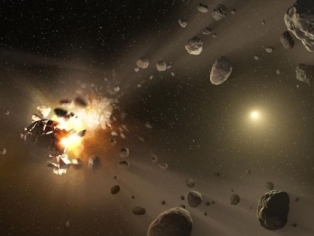
The results should worry anyone planning on living for the next million
years or so:
"The star that is set to come
closest is called Hip 85605, and has a 90 per cent
chance of reaching between 0.13 and 0.65 light years
away from us in the next quarter to half a million years
– although its current position data isn't entirely
clear so the estimate may be wrong. The next closest is
GL 710, which has a 90 per cent chance of reaching 0.32
to 1.44 light years in the next 1.3 million years.
"Either one
would be close enough to influence the Oort cloud, which
extends from 0.0065 to around 1.63 light years from the
sun. "I think we can safely predict that comet orbits
would indeed be disrupted by the closest encounters,"
says Bailer-Jones. He is now working on a follow-up
study to determine the probability of Earth being hit by
a comet as the result of a star passing by." (2)
Of course, this need not concern us unduly. But the modelling does
serve to show how passing stars might have affected the solar system
and, in particular, its extended Oort Cloud of comets in the past.
This offers an alternative explanation for non-random perturbation
effects calculated for long-period comets visiting from the outer Oort
Cloud. The new Monte Carlo calculations firm up past fly-bys of
stars, too:
"A
larger perturbation may have been caused by gamma
Microscopii, a G6 giant with a mass of about 2.5 Msol,
which came within 0.35-1.34 pc (90% confidence interval)
around 3.8 Myr ago." (3)
This turns out to be a shorter
distance (~1.14-4.37 light years) from the Sun than
previously calculated back in 2001:
"Backwards extrapolation of the motion of γ Microscopii
has shown that approximately 3.8 million years ago, it
was only around 6 light-years from the Sun."
(4)
Which means that it's possible that
the star Gamma Microscopii, which is over twice the mass
of the Sun, actually moved through the Sun's own
comet clouds in the period leading up to the Quaternary
Ice Epoch/Pleistocene 2.5 million years ago; an era that
saw major geophysical changes and the eventual emergence
of humanity. Might there be a link?
Written by Andy Lloyd, 12th January 2015
References:
1) Andrew Griffin
"End of the world: Humans could be killed off by hail of
comets from passing stars" 5 January 2015,
with thanks to Lee
independent.co.uk news
2) Jacob Aron
"Star's flying visit could fling comets at Earth" 17 December 2014
newscientist.com article
3) C.A.L.
Bailer-Jones "Close encounters of the stellar kind" 11 December 2014
arxiv.org abstract
4) J. García-Sánchez, et al "Stellar
encounters with the solar system", Astronomy and
Astrophysics, 379 (2): 634–659, 2001
aanda.org article
Missing Angular Momentum and the
Precession of the Equinoxes
"Dear Mr. Lloyd,
About 6 months ago or so I
read your book and became intrigued with the possibility you're
proposing. I'm an applied mathematician, formerly with Lockheed Martin,
and I've done some calculations on the angular momentum of the Sun being
in orbit with a potential dark companion. I don't know if you're aware
of this, but I believe your theory is testable. According to the laws of
celestial mechanics two bodies orbiting each other are really both
orbiting a fixed point in space between them, the location of their
common center of mass. That says the Sun is in orbit as well. To pick a
specific example (which I don't propose to be real at all), let's
suppose the dark star has a mass of say .0.40 % that of the Sun, an
orbital period of say 12500 years, an eccentricity of .50 and a semi
major axis of 540 AU (and a few other assumptions as well), then the Sun
would have an orbital radius of over 2 AU. This is substantial ! This
would mean that for this particular case the Sun would scribe an arc of
one degree about every 35 years. The Earth, being in orbit about the
Sun, would also sense that small rotation. Using existing gyroscopic
technology this rotation is detectable!
Do you have any labs there
in the UK to take this on? This could really be fascinating.
Sincere Regards,
Robert F." (1)
~~*~~
Hi R
.,
Thanks for your email. I have come to realise over
the years that a possible Dark Star companion would need to be quite a
bit further out to have so far evaded detection (particularly given the
I
.R. sky survey conducted by WISE in
recent years, which did not pick out a suitable candidate object). But
let's say that the figures you've supplied, quite reasonably selected to
reflect the ideas presented in my 2005 book, are a good starting point
for a testable examination.
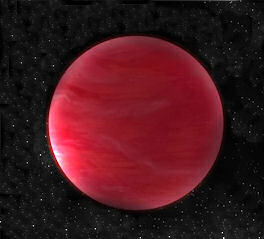
Around the same time as Dark Star was published,
there was another book along similar lines published by Walter
Cruttenden
(2) that considered an even larger
companion object (about 80Mj I think). He ended up accepting that the
proposition would not work (it would be a visible star, in reality).
Nonetheless, his proposal initially suggested that the very same effect
that I think you're discussing was apparent as Earth's Precession of the
Equinoxes. This wobble provides a scribing of one
degree of arc every 72 years, which is double the figure you suggest. If
Cruttenden is right in at least the suggestion of the effect being a
Dark Star causal mechanism, then that would give us a data point that
could be one step further towards suggesting its position.
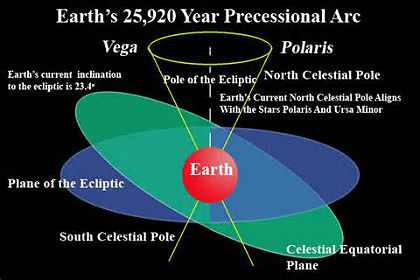
Earth's Precession effect provides a 'Great Year' of
about 25000 years, I seem to remember off the top of my head, so perhaps
that figure also reflects the orbital period of a possible Dark Star
companion as they gyrate around the same point in space?
(A complicating
matter: This solar system centre of gravity (its barycentre) fluctuates
with the movement of the planets
:
"Although it is
convenient to think of the Sun as the stationary
anchor of our solar system, it actually moves as the planets tug on it,
causing it to orbit the solar system's barycenter. The Sun never strays
too far from the solar system barycenter. The
barycenter is often outside the photosphere of the Sun, but never
outside the Sun's corona."
(3)
This is further complicated by the solar
system's overall movement towards the Solar Apex, which creates a
further fluctuation with respect to background stars. All
these calculations are based upon what we currently know about the solar
system - an additional companion object would mean shifting the assumed
parameters around.)
In a way, then, such an idea has already been tested.
The question is more properly - is this what accounts for Earth's
Precession effect?
Many thanks,
Andy
Lloyd
~~*~~
"Hello Andy,
I've
attached a paper I wrote recently on the dark star
to be published very soon on a friend's web site
(4). It goes into detail on the ideas I mentioned in
my earlier note, in particular on the role of
angular momentum in the solar system. Well known by
astronomers is that the Sun has over 99.9% of the
mass of the solar system but less than 4% of its
angular momentum. Astronomy has a tortured answer
for this, which strains credibility. On the other
hand I think the dark star can solve the mystery,
which I explain in detail in the paper. I analyze
several different orbits for the dark star including
Mr. Cruttenden's proposed orbit of 25000 / 26000
years.
Regarding Mr's Cruttenden's theory that the dark
star might be connected to the precession of the
Earth's axis (i.e. the equinoxes), I'm afraid he's
off base. Precession of spinning tops, of which the
earth is a very large example, is very well
understood by physics. Tops precess because of a
force acting on the top along a line different from
that of the top's spin axis. In the case of the
Earth's precession, the gravity of the Sun and Moon
provide the necessary force and the Earth's tilt
provides the skewed angular deviation. Many complex
papers have been written about this but I like this
easy-to-read explanation by a physics professor at
Northwestern University who explains the details and
derives the rate much more clearly than most (5).
That
said, you do have an interesting point, however.
Even though the gravity of the Sun and Moon account
for the Great Year, there is another very subtle
effect that comes into play. If there is a dark star
orbiting the Sun then both bodies are actually in
orbit about their common center of mass as we know.
The Sun then moves in an orbit in space as well and
has a centripetal force acting on it that's
proportional to the square of its angular velocity,
which would also contribute to the precession except
that it's so very tiny that it essentially gets
lost. But even though the force is very slight an
extremely sensitive gyroscope should be able to
sense it if the dark star's period isn't too large,
which would prove the existence of your dark star.
As
you'll see from my paper I believe this dark star,
probably a brown dwarf, has already been detected at
about 50 billion miles out. The evidence for this is
explained in the first section.
The
paper explains all this in more detail. Your
thoughts are very much appreciated.
Kind
regards, Robert F."
(6)
~~*~~
Hi Robert,
Thanks
for your email, which I find myself very much in
agreement with, and also the attached document which
contained many fascinating discussion points
regarding scenarios presented by Sitchin, Warmkessel,
Muller and several others. The detail that you have
presented about the potential missing angular
momentum, and how that compares with studies of
various accretion disks was particularly helpful I
thought.
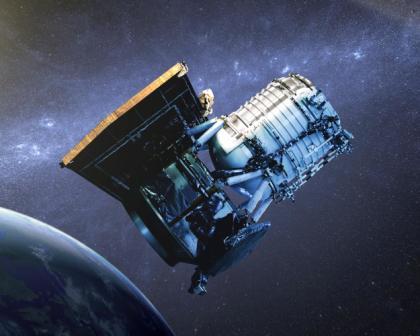
The main problem we all face is the glaring issue of
why such an object has yet evaded detection. IRAS
came up with some hints of objects out there, and a
case can be made that the American part of the group
studying the pertinent IRAS data fumbled the ball
back in the mid-1980s. But WISE really should have
done a better job, particularly given the
improvement in the resolution of their imagery, and
the computing power this more modern search brought
to bear. However, candidate objects from WISE seem
sparse indeed, even for possibilities involving the
outer Oort Cloud. Matese and Whitmire have
presented just a few possibilities from their trawls
through the data (7).
Planet
hunters like Mike Brown seem to think that the solar
system possibly once had a dark companion (8,9), but
that it has been lost to interstellar space over
time. This must be a possibility I guess, although
I would have thought that within an adiabatic system
like the solar system that such a major transition
would have involved some deep-seated adjustments in
orbital energy levels throughout the planetary zone.
Perhaps such a transition might have accounted for
the kinds of migratory patterns many astronomers now
project for the gas giants in the evolving solar
system?
Or, maybe it
really is still out there and is a misidentified
object. Personally, I favour a highly elliptical
orbit that produces very little lateral vector
across the sky. That way a warm object might have
been overlooked or misidentified on the basis of an
assumption of more or less circular trajectories
around the Sun. But that's speculative, as is much
in this field. The indirect evidence for its
existence is strengthening by the year, in stark
contrast to the lack of supportive data from sky
surveys. It's a puzzle, to be sure.
Many thanks,
Andy Lloyd
References:
1) Correspondence received from
Robert F., 9 January 2015
2) Walter Cruttenden "Lost Star of Myth and
Time" St Lynn's Press, 2005
 Lost Star of Myth and Time
Lost Star of Myth and Time
3) "The Solar System Barycenter"
orbitsimulator.com article
4) Robert F. "The Sun's Dark
Companion According to Physics" 2015
5) "The Precession
of the Earth’s Axis" (document no longer
available online)
6) Correspondence
received from Robert F., 10 January 2015
7) Matese and
Whitmire "Searching the WISE Preliminary Catalog for
Massive Planets in the Oort Cloud" EPSC-DPS Joint
Meeting 2011
ucs.louisiana.edu document
8) "Nemesis (Hypthetical Star) - Orbit of Sedna"
wikipedia.org wiki
9) Cal Fussman "The Man Who Finds Planets"
Discover magazine, 27th May 2006,
http://discovermagazine.com/2006/may/cover
Issues around a
Proposed 'Black Star'
I recently shared a discussion by
email with a Planet X researcher called Terral Croft,
focussed upon a variation of the Dark Star concept that
he has been working on and blogging about online for
about five years (since the advent of Comet Elenin) (1).
He calls this object a 'Black Star' (a
"collapsed binary twin
to our Sun that is something between a black dwarf and
neutron-type star that releases no light in the visible
or infrared spectrum" (2)). He believes
that it is currently moving through the planetary zone
of the solar system, based upon a raft of evidence
bringing together an uptick in seismic and other
geophysical changes, anomalous meteorological events,
and various anomalies within the solar system, gathered
together succinctly in this subsequent email:
"What could
possibly cause the heliosphere to shrink 25 percent in just
the last 10 years 'and' weaken Earth magnetosphere
proportionately 'and' cause 6 to 8-magnitude earthquake
values to go parabolic 'and' cause Jupiter's core to liquefy
'and' create Saturn's recent super storms moving through
Cancer/Leo 'and' turn Earth magnetosphere around for 28
hours (3.12-13.2012) and do that one year and one day
'after' Fukushima (3.11.2011) and cause the associated Earth
Axis Shift 11 days in the year 'after' the 8.8 Chile Quake
(2.27.2010) causing another large Earth Axis Shift 'and'
cause massive northern ice sheet depletion 'and' ocean
conveyor disruption 'and' jet stream fluctuations leading to
strange weather anomalies 'and' mass animal deaths at
predictable times 'and' magnetic North Pole migration using
a series of predictable path loops 'and' explain higher
numbers of comets, asteroids, meteors/fireballs falling out
of orbit 'and' a seismic pattern going back to 1965 'and'
predictable earth change upticks/lulls 'and' the recent
global sinkhole uptick 'and' explain bipolar condition in
humans multiplying 40 times since 2003 'and' the recent
global volcanic uptick 'and' lettered agency psyops using
Elenin and ISON Comets claimed to be 'controlled'
representing the first two hyperbolic comets discovered by
Russians 'and' explain Mars' broken magnetic portal
connection/missing magnetosphere, Venus' slowing retrograde
rotation, Uranus' robust seismicity, global warming and
warming of all the planets in the solar system, Solar Cycle
24 flat lining at the end of 2011 'and' the earth change
events connected to the accounts of Noah 'and' Moses that
coincide with the Nibiru orbit period from the Sumerian
Tablets 'and' the prophecies of Jesus Christ from Matthew 24
(Joel 2) and Revelation (Wormwood) 'and' just for starters?
Replacing the 'and' with 'or' creates a wide spectrum of
probabilities, but all of these symptoms together at the
same time allows us to eliminate the impossible and
improbable to find the truth.
"My
question to you is: What can possibly create all of these
symptoms except the near proximity of an invisible star? My
answer is nothing, leading to my conclusion that the
Black/Dark Star is much nearer than many realize. You
mentioned that your Dark Star would be located in the same
position, as Earth moves in natural orbit around the Sun.
However, the evidence says we have a clear seismic pattern
where the celestial/invisible star-like object is moving
'left' in the orbit diagram (prograde) at a rate of 5.5
degrees for every 188 days (2010-11) and that rate is
INCREASING to indicate our Black Star is reaching
perihelion. This object cannot possibly be very far away
from Earth 'and' move with this velocity through the
ecliptic constellations. My feeling is that you will draw
similar conclusions, but only if you take the time to
actually gather all the evidence to formulate and prove the
hypothesis right or wrong; allowing us the opportunity to
draw the right conclusions about what is happening all
around us. The obvious truth for me is that we are dealing
with a spiritual entity that is actively masking these
truths and evidence that has been hidden deliberately in
plain sight. So far, the evidence indicates that the
Marshall Masters, Keith Hunters and James McCanneys of the
world look at a very small part of the evidence with little
or no desire to invest the time for running a real Project
Black/Dark Star investigation and all the related evidence."
(3)
~~*~~
Although Terral published our correspondence up until
this point on his monthly newsletter (4), he has not yet included my
next reply, outlining some of the issues that challenge his hypothesis
(sent 2nd January 2015). Here's what I said:
Hi Terral,
Thank you for your detailed reply, and the
information that you have laid out as evidence for an incoming Dark Star
object. As you say, many of these are localised issues which taken
independently would be explainable individually as part of general
earth-changes within the cyclical roller-coaster of natural events. What
you are addressing is whether there is a pattern emerging from this data
that might indicate a common source causing this disparate effects. Any
kind of scientist worth his/her salt is in the job of trying to spot
such patterns and learn from there. That's how discoveries are made, so
your line of enquiry is both valid and, for all anyone knows, extremely
timely.
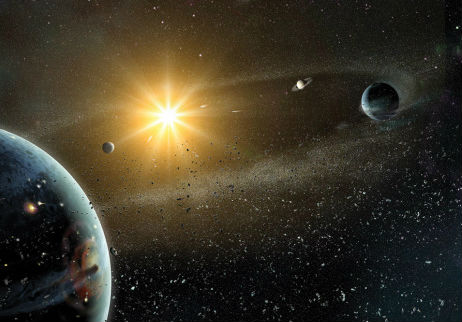
Let us say that a number of these factors (I'm
particularly thinking of the geophysical ones) are anomalous enough to
require a common explanation.
-
We can look at the Earth's own cyclical behaviour
(e.g. Milankovitch cycles), it's propensity for catastrophism
(under-appreciated, in my view) and its underlying fragility in
terms of its ability to offer stable support for varied ecosystems.
We can look at the Sun, which remains an
unpredictable and mysterious stellar object in terms of the
mechanics of its cycles and behaviour, and its potentiality to
unleash storms upon the solar system that inflict immense damage.
Then we can look at rogue objects potentially
lying undiscovered in the depths of the solar system which, like the
comets, might periodically reappear as a Wild Card to stir things
up.
Stepping out of these apparently isolated frames of
reference and looking at the situation as a whole, one might propose a
situation whereby the Wild Card cyclically steps into the fray, and
provides the overall system with a whole new cycle to take into
consideration, in the form of gravitational and magnetic disturbances.
Thus, a Gestalt is potentially at play, providing the cause and effect
mechanism for a large scale pattern of change that Science at this time
is blind to. This, I think is a reasonable premise to work from, in
terms of the study of solar system catastrophe and more importantly, the
ability to predict future events and outcomes.
I think that it's also reasonable to look back at
myths and oral traditions to see patterns of catastrophe in historical
and prehistorical times to determine when previous passages of this
object might have taken place. Tying down dates for an Exodus event
(which is necessarily tied to a contemporary perihelion passage, if
working on the 3600 year Sitchinite scenario) is, frankly, very
problemati
c. Hebrew Scripture about this allegedly
historical event has no parallel in written ancient Egyptian records,
which are extensive. Hence, to make such a leap we are reliant totally
upon the Bible's account and scholarly interpretations of the chronology
involved - all of which is wide open for debate, I would argue. But,
let's say you're right...
Then, we turn to the nature of the celestial Beast
that we are both hunting. You say:
"The binary
twin to our Sun is no brown dwarf star, or our resident astronomer could
see the black hole-like object using his observatory-class telescope and
infrared accessories. We are dealing with the collapsed binary twin to
our Sun that is something between a black dwarf and neutron-type star
that releases no light in the visible or infrared spectrum."
(2)
This, too, is arguable. I would agree that the rogue
object is unlikely to be a 'brown dwarf star'. My initial proposals all
those years ago, which have stuck in the Planet X mythology ever since,
did call for a brown dwarf failed star, but I have realised subsequently
that the object would need to be much cooler, and less heavy - probably
a sub-brown dwarf object of Jupiter proportions, but with a much-reduced
heat and light signature. Its gravity alone would thus be sufficient to
warm its moons and create habitable conditions there, which is the main
thrust of the Dark Star Theory Any other emissions of warmth and cool
light are a bonus.
The ability to observe reflected light (I'm thinking
specifically of planets) drops away to the fourth power with distance.
Which is why we can't see Uranus and Neptune, even though they are much
bigger than the inner solar system planets (which do appear in the sky).
So, a sub-brown dwarf could be out there, although at a considerable
distance to have avoided detection with an instrument such as WISE. You
are perfectly correct to make the point that an incoming,
perihelion-cruising object of planetary size would be seen quite readily
within the solar system.
To consider the potential for such an object in the
planetary zone at this time, it's necessary to pull the parameters for
this object's size right down. Therefore, to make this 'fit', then your
proposal for some kind of ultra-dense, small and dark object would, on
the face of it, fit the bill. Effectively, you're proposing a
neutron-star like object which would have strong gravitational
capabilities to affect other solar system bodies, and significant
magnetic properties, too. You say it would be cool (arguable) and dark,
thus evading direct detection in standard telescopes, but also IR
surveys (like WISE and IRAS).
However, such an extremely dense 'star' would be a
highly energetic object indeed. It would be likely to emit significant
streams of all kinds of high energy radiation; like X-rays and
microwaves, and possibly even gamma-ray bursts. Given that astronomers
scan the skies in these frequencies too, then such an object would stand
out as a strong anomaly in the local cosmic environment. In other words,
they'd easily spot it at really quite considerable distances, let alone
right on top of us. In that important respect, the Black Star idea
creates a detection issue that is far worse than the problems attached
to a mere sub-brown dwarf. That, in a nutshell, is why I'm skeptical of
this particular solution.
The only way it could conceivably work is if the
neutron star is non-accreting, and non-spinning:
"Some neutron
stars rotate very rapidly (up to 716 times a second,[8][9] or
approximately 43,000 revolutions per minute) and emit beams of
electromagnetic radiation as pulsars. Indeed, the discovery of pulsars
in 1967 first suggested that neutron stars exist. Gamma-ray bursts may
be produced from rapidly rotating, high-mass stars that collapse to form
a neutron star, or from the merger of binary neutron stars. There are
thought to be on the order of 108 neutron stars in the galaxy, but they
can only be easily detected in certain instances, such as if they are a
pulsar or part of a binary system. Non-rotating and non-accreting
neutron stars are virtually undetectable; however, the Hubble Space
Telescope has observed one thermally radiating neutron star, called RX
J185635-3754." (5)
But, even in this case, the intense gravitational
well associated with the object would still provide a glaring anomaly
for astronomers - there would be a significant gravitational lensing
effect of background starlight being distorted by this super-dense star.
These kinds of Relativity effects are well known. Given that the alleged
object is moving through perihelion, and given parallax effects
associated with the shifting position of the Earth in relation to its
own movement, then that lensing effect would be non-stationary, and thus
even more anomalous. For scientists to have missed such a unique,
glaring celestial event requires conspiracy theories of significant
proportions.
Many thanks,
Andy
Lloyd
~~*~~
We had a further exchange of emails along similar
lines, which helped to clarify a few things, and I invited Terral to
make some predictions about how the object he has described might affect
the Earth in the future. He sent me this correspondence, which
outlines what he thinks is likely to come to pass in the next six months
or so:
"Hi
Andy:
"Thank you
for writing and, yes, sharing. I appreciate hearing your
views very much. Earth passed between the Sun and Black Star
around the second to third week of April 2014, when we had
an 8-magnitude quake, six 7-magnitude quakes and seventeen
6-magnitude quake events in a 19-day period. Earth crossed
Black Star Orbit Path on May 20, 2014 for the magnetic North
Pole to reach the bottom of the recent path loop farthest
from Siberia on May 21, 2014. Earth moved to outside-orbit
position making the right triangle with the Black Star
relative to the Sun around the third week of July 2014 to
begin the back orbit phase of the 2014 Earth Orbit Cycle
that marked the 'low' value of 2.5 to 4-magnitude
earthquakes at 177 (high cycle value was 536); just one
quake different from the week of January 5, 2014 marking the
start of the 2014 Earth Orbit Cycle. Earth passed behind the
Sun relative to the Black Star amid another flurry of
X-class flares on November 15, 2014 to begin the current
earth change lull period that will end around the first of
February 2015 to begin the next orbit cycle. Then a massive
earth change uptick period will begin, until Earth again
passes between the Sun and Black Star in the month of May
2015.
"There is
a disparity between the nearside and backside alignments
that is yet to be understood, but look for many
high-magnitude quake events for the month of May 2015 very
close together; as the Earth once again passes between the
two binary twin stars with another round of fluctuations in
Earth magnetosphere; as the heliosphere and magnetosphere
continue to weaken from nearing Black Star proximity and
rising percentage of Sun/Black Star magnetic portal inner
active conduits. The primary Sun/Black Star magnetic portal
connection will have reduced insulation properties, as inner
active portal conduits become increasingly pressurized to
grow in diameter forcing the smaller passive conduits to the
exterior for increased Sun/Earth/Black Star portal-to-portal
cross firing creating inner solar system environmental
conditions conducive to large X-class solar flare
generation; as the Sun interprets increased electromagnetic
cloud influences as foreign inbound bodies to launch defense
countermeasures. Hopefully we are not looking at a Black
Star/Earth crossing event anytime soon, but we are running
out of space in the orbit diagram for this to take very much
longer; as the nearside alignment quake events are
converging on the Earth/Black Star crossing date indicating
that the Black Stat (sic) has arrived.
"Thank you again for sharing,
References:
1) Terral Croft
terral03.com
2) Correspondence from Terral Croft, 31 December 2014. Note this entry for 'Black Dwarf' on Wikipedia:
"A black dwarf is a white
dwarf that has sufficiently cooled that it no longer emits
significant heat or light. Because the time required for a white dwarf
to reach this state is calculated to be longer than the current age of
the universe (13.8 billion years), no black dwarfs are expected to exist
in the universe yet, and the temperature of the coolest white dwarfs is
one observational limit on the age of the universe."
("Black
dwarf
wikipedia.org/wiki/Black_dwarf)
3) Correspondence from Terral Croft, 1 January 2015
4) Terral Croft "Terral's 2015 Newsletter Volume 1"
5) "Neutron Star"
wikipedia.org/wiki/Neutron_star
6) Correspondence from Terral Croft, 4 January 2015
Previous Blog
Next Blog

Dark Star Blog Index
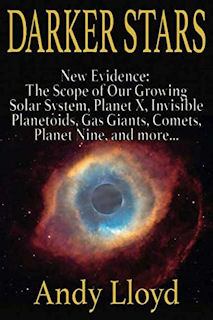
Dark Star
Books Index

You
can keep informed of updates
by following me on Twitter:
www.twitter.com/#darkstarandy

Or like my Facebook Page:
https://www.facebook.com/darkstarandylloyd
















